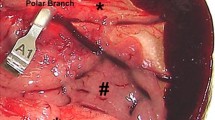Summary
To elucidate the pathogenesis of acute acalculous cholecystitis, the gallbladder was subjected to ischemia-reperfusion by simultaneously occluding the middle hepatic artery and the superior mesenteric vein in dogs, and the degree of inflammation and biochemical changes in the gallbladder mucosa were studied by varying the duration of ischemia or reperfusion. Ischemia alone did not induce cholecystitis either macroscopically and histologically, although it increased phospholipase A2 (PIA2) activity, content of lipid peroxide, and Superoxide dismutase (SOD) activity in the mucosa with prolongation of the ischemic time. Cholecystitis was produced in all animals by 45-min ischemia followed by 90-min reperfusion as the shortest ischemia and reperfusion times. In this model, prolongation of the ischemic time increased the area of mucosal inflammation horizontally with increases of the PIA2 activity, content of lipid peroxide, and SOD activity, whereas by prolonging the reperfusion time the inflammation area spread deeper vertically toward the serosal side with significant increase in the mucosal PIA2 activity, content of lipid peroxide, and SOD activity. These results revealed that ischemia-reperfusion plays an important role in the pathogenesis of acute acalculous cholecystitis, causing the generation of free radicals and the activation of membrane-bound PIA2.
Similar content being viewed by others
References
Gleen F: Acutc cholecystitis following the surgical treatment of unrelated disease. Ann Surg 1947;126:411–420.
Thomas CG, Womack NA: Acute cholecystitis, its pathogenesis and repair. Arch Surg 1952;64:590–592.
More BM, Merdinger WF, Sommers SC, et al: Cholecystitis and stenotic arteriosclerosis. Am J Clin Path 1966;45:465–469.
Iancy ER, Ito S: Microscopic analysis of ethanol damage to rat gastric mucosa after treatment with a prostaglandin. Gastrocnterology 1982;83:619–625.
Isaji S: Pathogenesis of fat necrosis in acute pancreatitis, with special reference to the role of pancreatic phospholipase A2. Mie Med J 1985;35:109–123.
Yagi K: A simple fluorometric assay for lipidperoxide in blood plasma. Biochem Med 1976;15:212–216.
Hiramatsu M, Kouno M: Determination of Superoxide dismutase activity by Electron Spin Resonance Spectrometry using spin trap method. JEOL NEWS 1987;23:7–9.
Lowry OH, Rosenbrough NJ, Farr AL, et al: Protein measurement with the Folin phenol reagent. J Biol Chem 1951;193:265–275.
Yoshikawa T, Kondo M: Biochemical mechanisms and clinical findings of free radicals. Nipponrinsho 1988;46:2241–2245. (in Japanese)
Isaji S, Taoka H, Mizumoto R, et al: The role of lipid peroxide and phospholipase A2 in acute pancreatitis, with special interest to the pathogenesis of fat necrosis, respiratory and renal failures. In: Tsuchiya M, ed. Free radicals in disease. Excepta Medica, Amsterdam. 1988;215–220.
Mersereau WA, Hinchey EJ: Effect of gastric acidity on gastric ulceration induced by hemorrhage in the rat, utilizing a gastric chamber technique. Gastroenterology 1973;64:1130–1135.
Watt J: The mechanism of histamine ulceration in the guinea pig. Gastroenterology 1959;37:741–759.
Sies H: Oxidative stress. Translation Copyright. 1st ed. Japan Scientific Societies Press, Tokyo 1987;163–166.
Haglund U, Arvidsson S, Schoenberg H: Oxyradicals and acute gastrointestinal mucosal damage. In: Novelli GP, ed. Oxigen Free Radicals in Shock. 1st ed. Karger publication, Florence. 1986;197–204.
Van Kunk FJG, Handelman GJ, Dratz EA, et al: Consecutive action of phospholipase A2 and glutathione peroxidase is required for reduction of phospholipid hydroperoxide and provides a convenient method to determine peroxide values in membrane. J Free Radicals in Bio 1985;1:421–427.
Reimer KA, Jennings RB: Failure of the xanthine oxidase inhibitor allopurinol to limit infarct size after ischemia and reperfusion in the dog. Circulation 1985;71:1069–1075.
Egan KW: Mechanism for irreversible self-deactivation of prostaglandin synthctase. J Biol Chem 1976;251:7329–7338.
Atalla SL, Pereyara LH, Mackenzie GH, et al: Influence of oxygen derived free radical scavengers on ischemie liver. Transplantation 1985;40:584–589.
Author information
Authors and Affiliations
Rights and permissions
About this article
Cite this article
Taoka, H. Experimental study on the pathogenesis of acute acalculous cholecystitis, with special reference to the roles of microcirculatory disturbances, free radicals and membrane-bound phospholipase A2 . Gastroenterol Jpn 26, 633–644 (1991). https://doi.org/10.1007/BF02781681
Received:
Accepted:
Issue Date:
DOI: https://doi.org/10.1007/BF02781681




